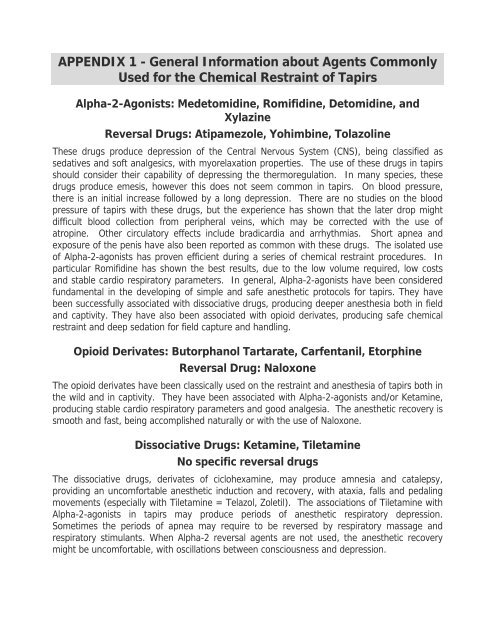TAPIR FIELD VETERINARY MANUAL - Tapir Specialist Group
TAPIR FIELD VETERINARY MANUAL - Tapir Specialist Group
TAPIR FIELD VETERINARY MANUAL - Tapir Specialist Group
You also want an ePaper? Increase the reach of your titles
YUMPU automatically turns print PDFs into web optimized ePapers that Google loves.
APPENDIX 1 - General Information about Agents Commonly<br />
Used for the Chemical Restraint of <strong>Tapir</strong>s<br />
Alpha-2-Agonists: Medetomidine, Romifidine, Detomidine, and<br />
Xylazine<br />
Reversal Drugs: Atipamezole, Yohimbine, Tolazoline<br />
These drugs produce depression of the Central Nervous System (CNS), being classified as<br />
sedatives and soft analgesics, with myorelaxation properties. The use of these drugs in tapirs<br />
should consider their capability of depressing the thermoregulation. In many species, these<br />
drugs produce emesis, however this does not seem common in tapirs. On blood pressure,<br />
there is an initial increase followed by a long depression. There are no studies on the blood<br />
pressure of tapirs with these drugs, but the experience has shown that the later drop might<br />
difficult blood collection from peripheral veins, which may be corrected with the use of<br />
atropine. Other circulatory effects include bradicardia and arrhythmias. Short apnea and<br />
exposure of the penis have also been reported as common with these drugs. The isolated use<br />
of Alpha-2-agonists has proven efficient during a series of chemical restraint procedures. In<br />
particular Romifidine has shown the best results, due to the low volume required, low costs<br />
and stable cardio respiratory parameters. In general, Alpha-2-agonists have been considered<br />
fundamental in the developing of simple and safe anesthetic protocols for tapirs. They have<br />
been successfully associated with dissociative drugs, producing deeper anesthesia both in field<br />
and captivity. They have also been associated with opioid derivates, producing safe chemical<br />
restraint and deep sedation for field capture and handling.<br />
Opioid Derivates: Butorphanol Tartarate, Carfentanil, Etorphine<br />
Reversal Drug: Naloxone<br />
The opioid derivates have been classically used on the restraint and anesthesia of tapirs both in<br />
the wild and in captivity. They have been associated with Alpha-2-agonists and/or Ketamine,<br />
producing stable cardio respiratory parameters and good analgesia. The anesthetic recovery is<br />
smooth and fast, being accomplished naturally or with the use of Naloxone.<br />
Dissociative Drugs: Ketamine, Tiletamine<br />
No specific reversal drugs<br />
The dissociative drugs, derivates of ciclohexamine, may produce amnesia and catalepsy,<br />
providing an uncomfortable anesthetic induction and recovery, with ataxia, falls and pedaling<br />
movements (especially with Tiletamine = Telazol, Zoletil). The associations of Tiletamine with<br />
Alpha-2-agonists in tapirs may produce periods of anesthetic respiratory depression.<br />
Sometimes the periods of apnea may require to be reversed by respiratory massage and<br />
respiratory stimulants. When Alpha-2 reversal agents are not used, the anesthetic recovery<br />
might be uncomfortable, with oscillations between consciousness and depression.










